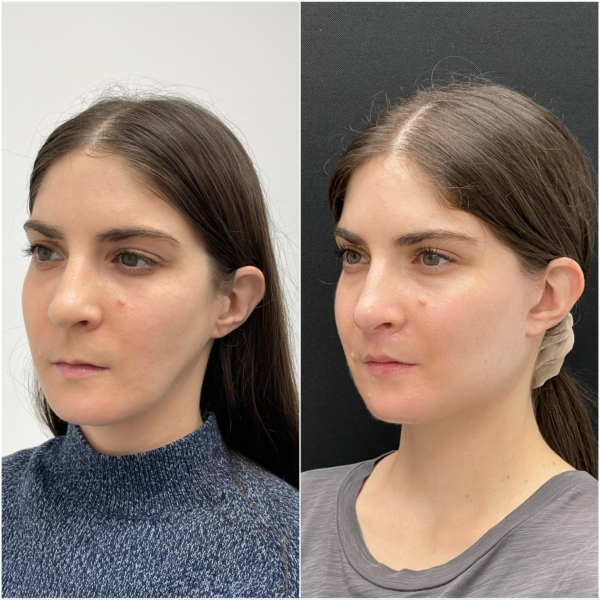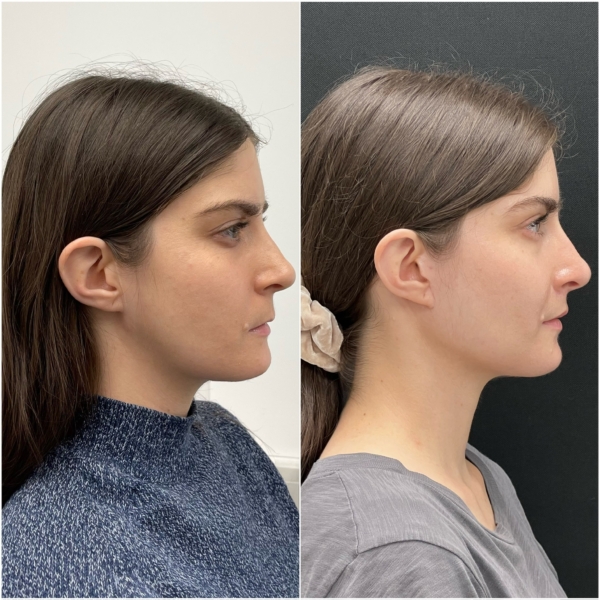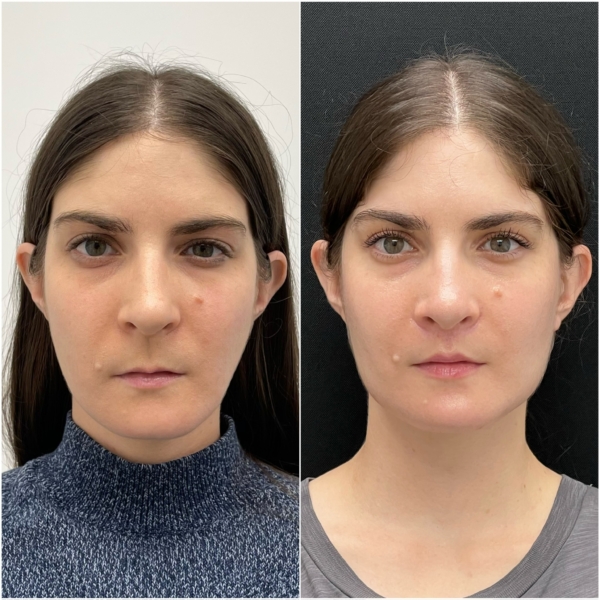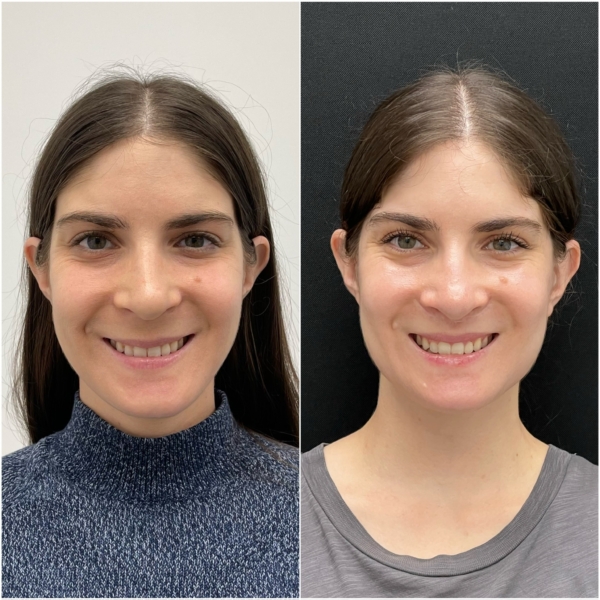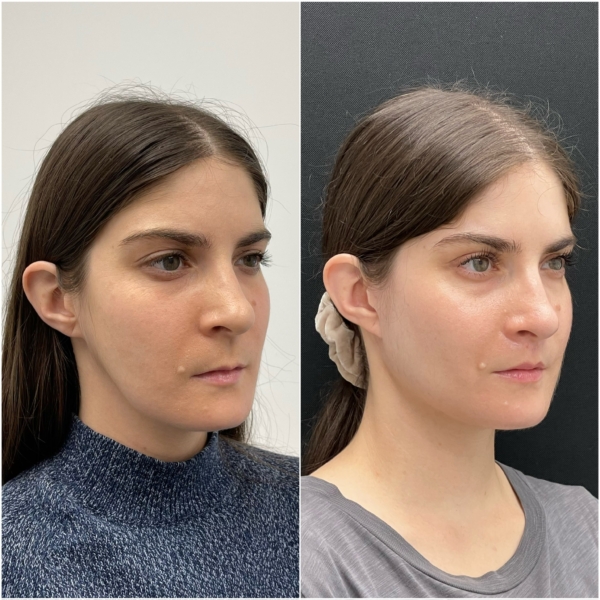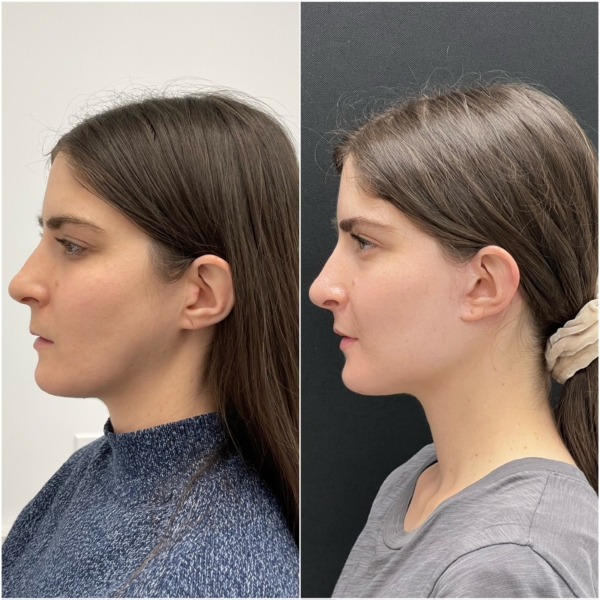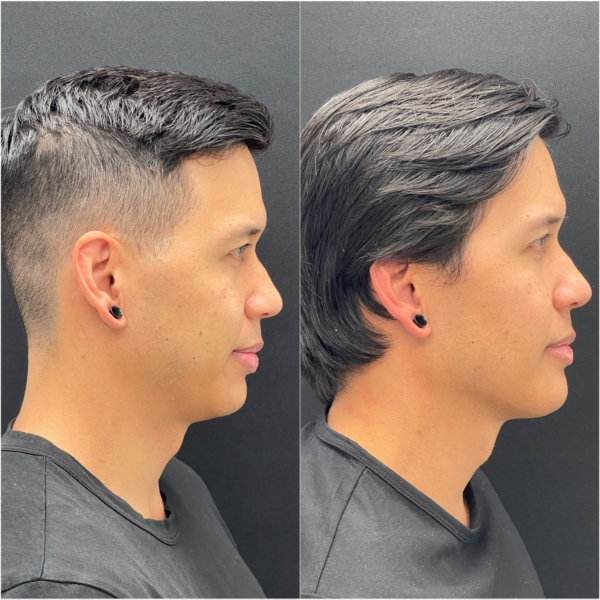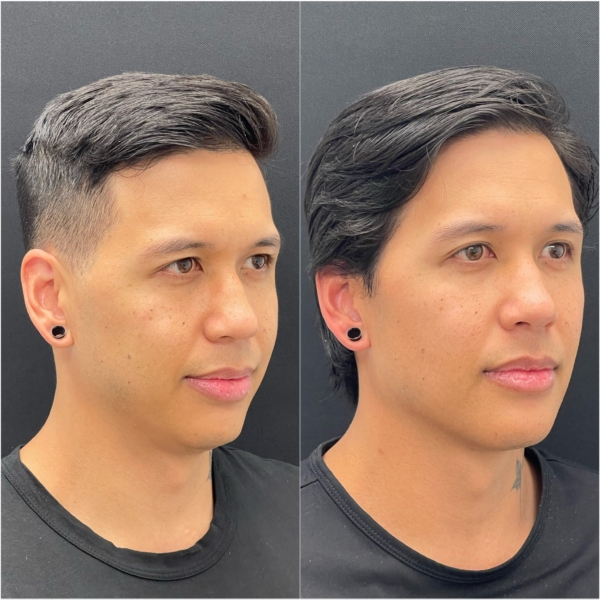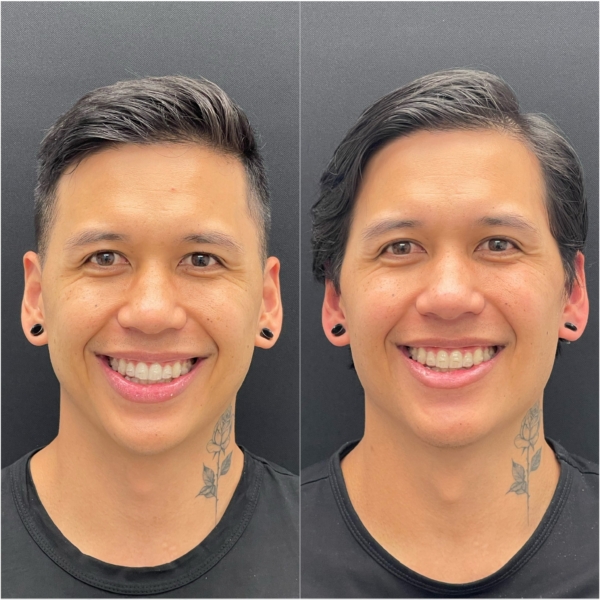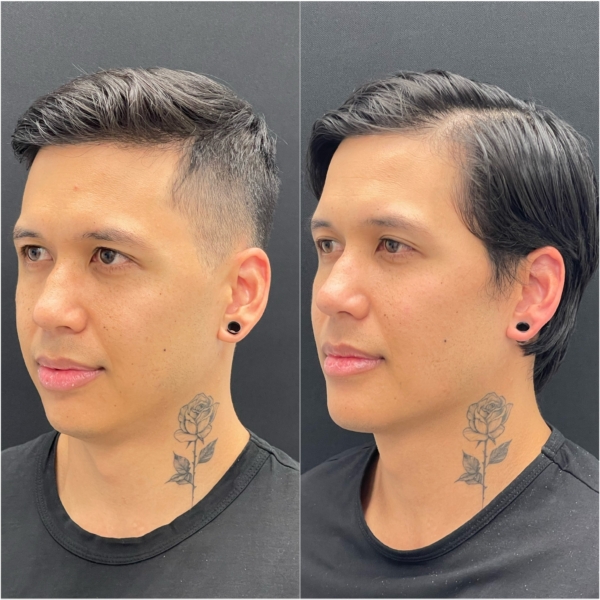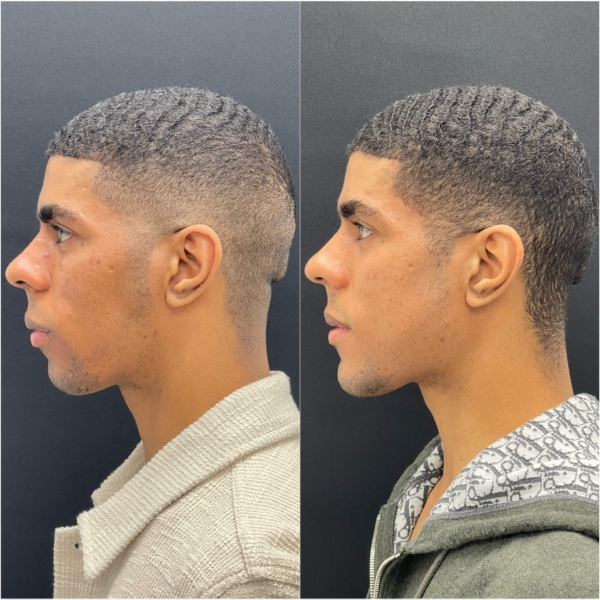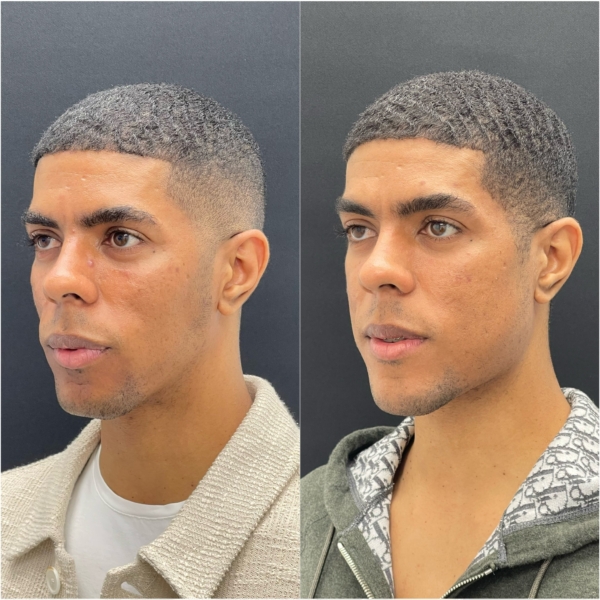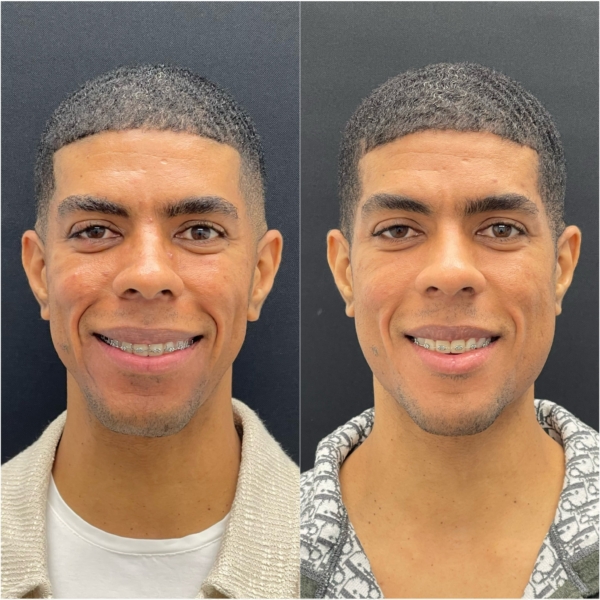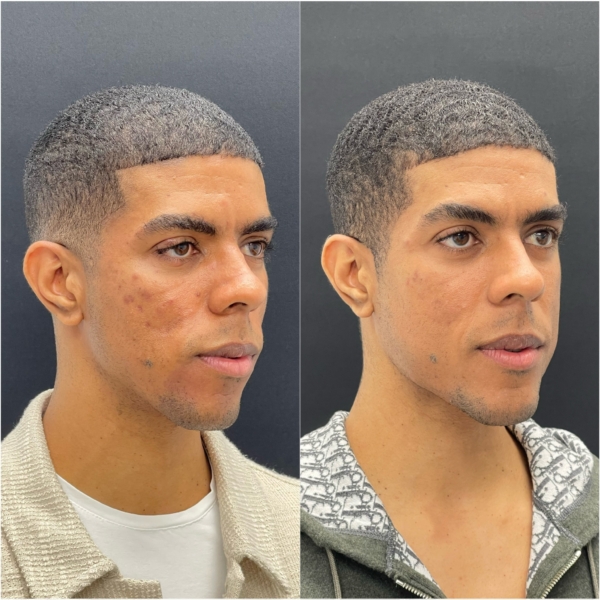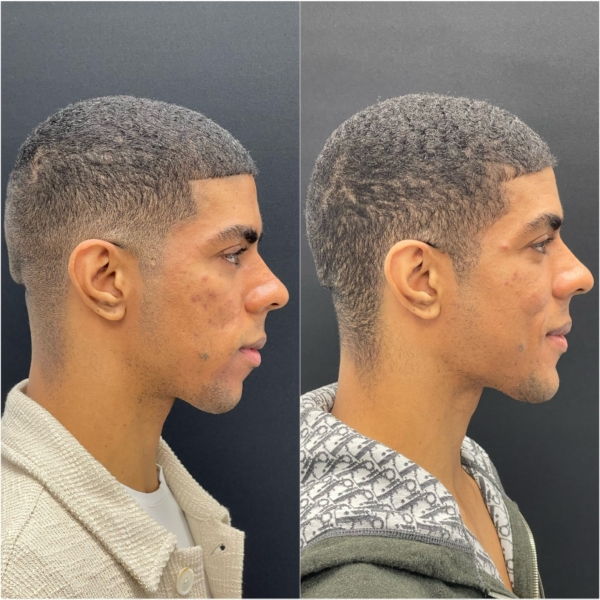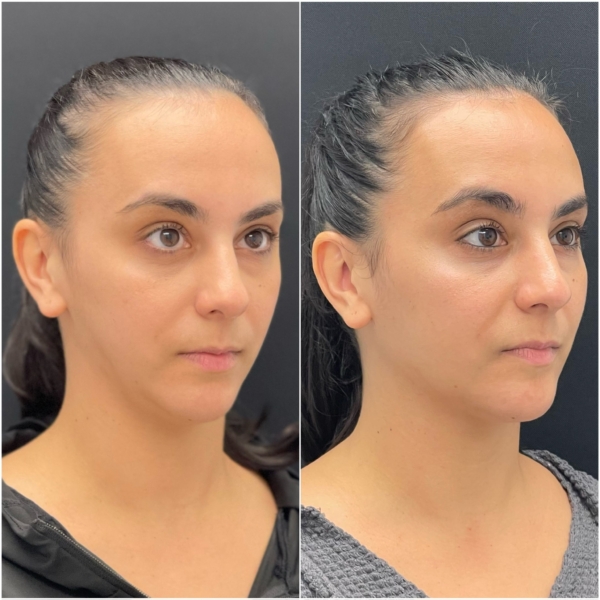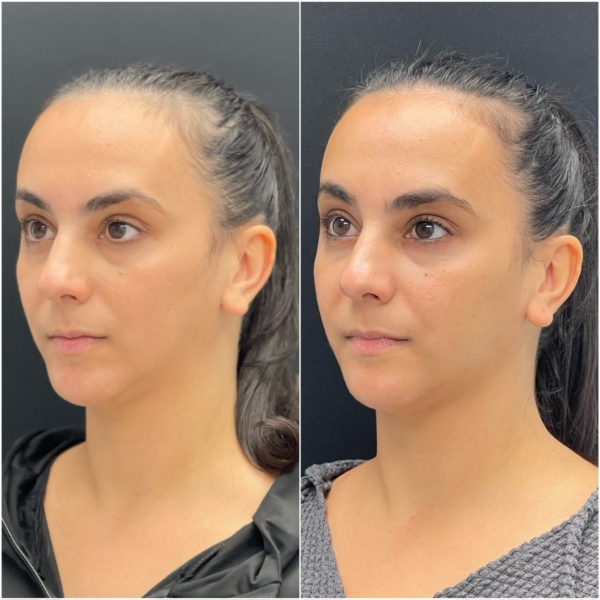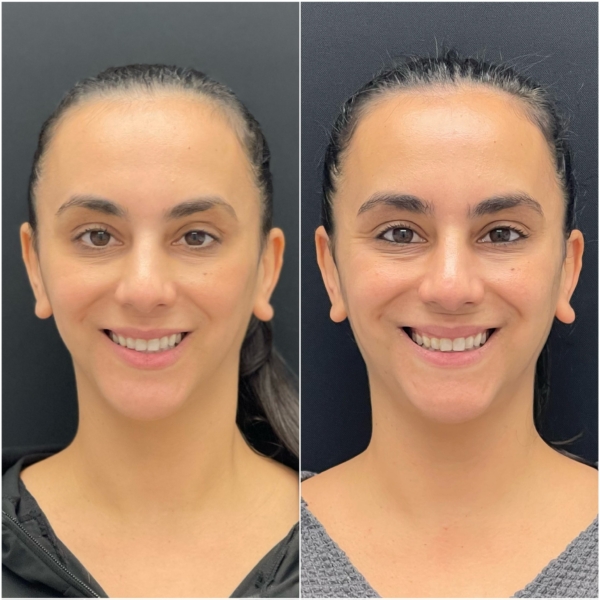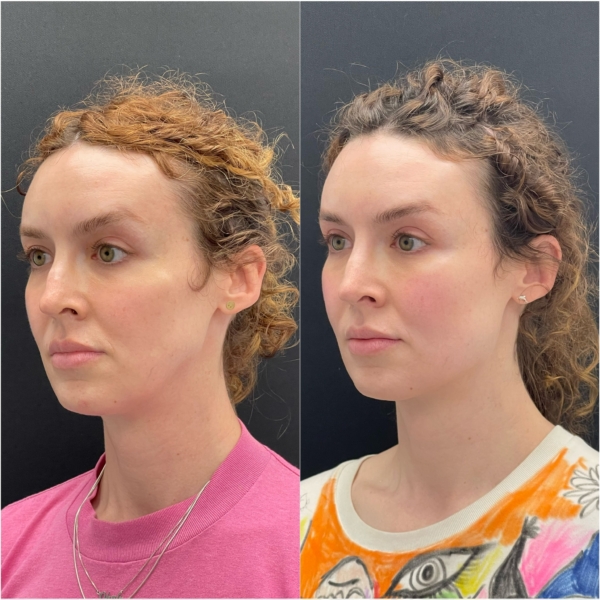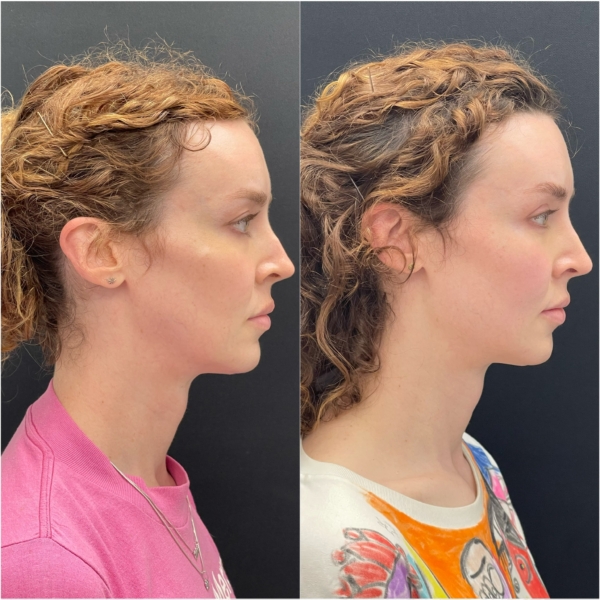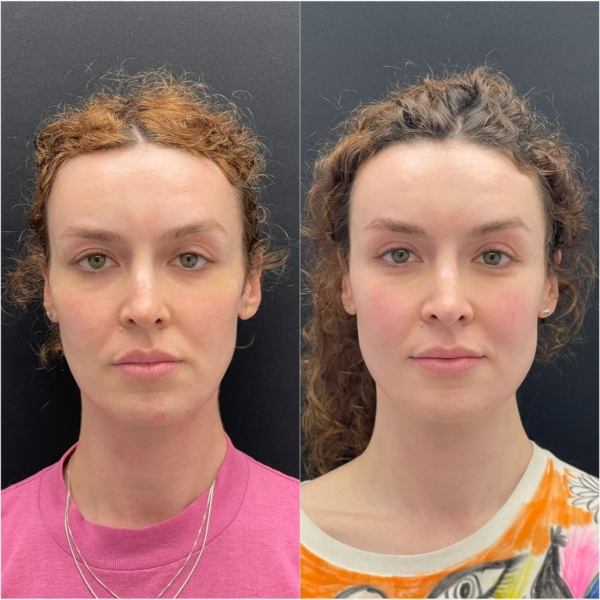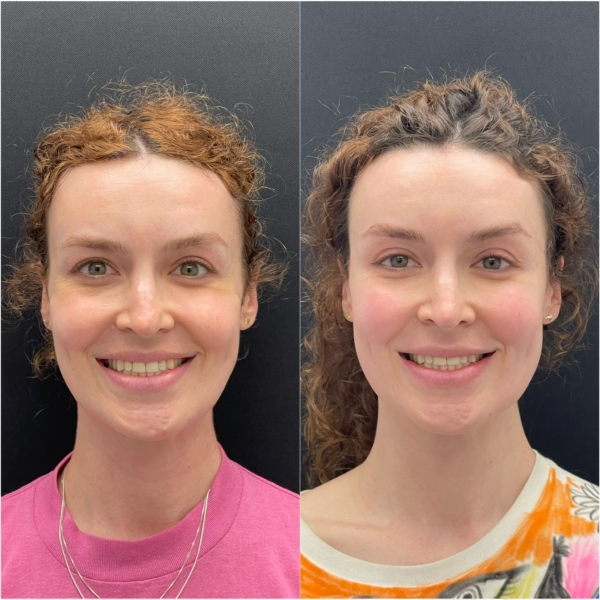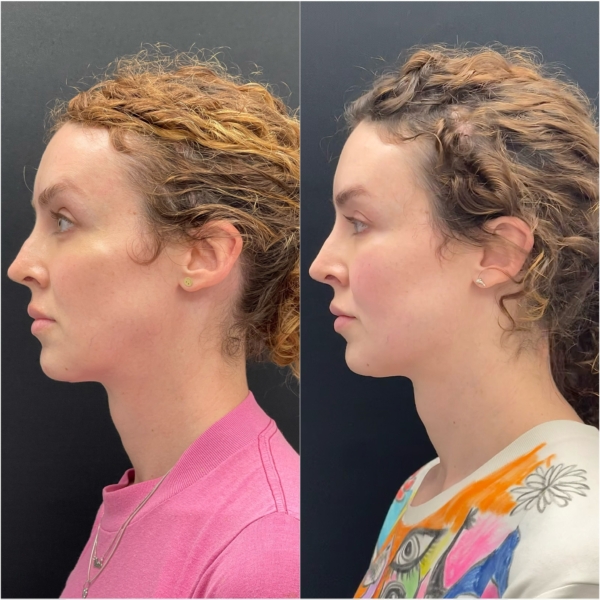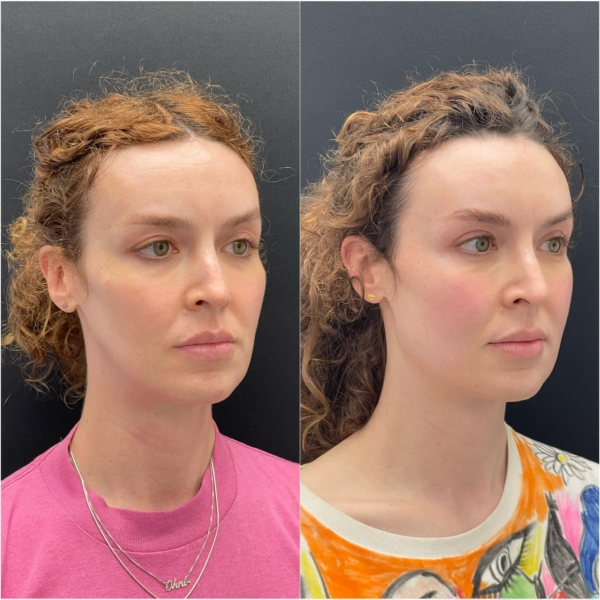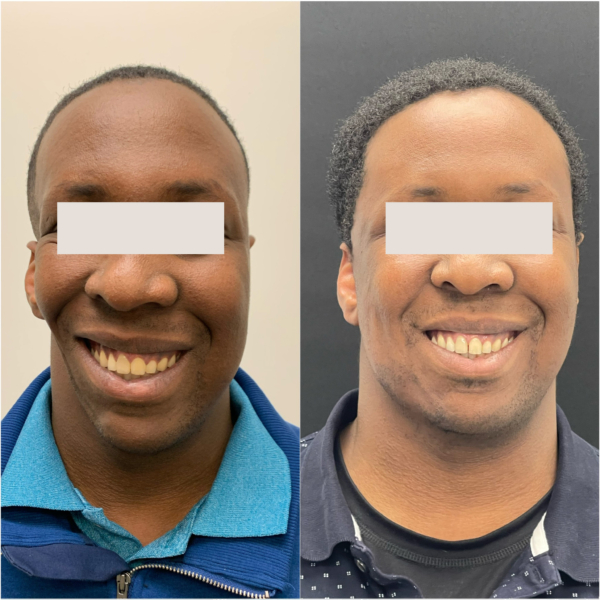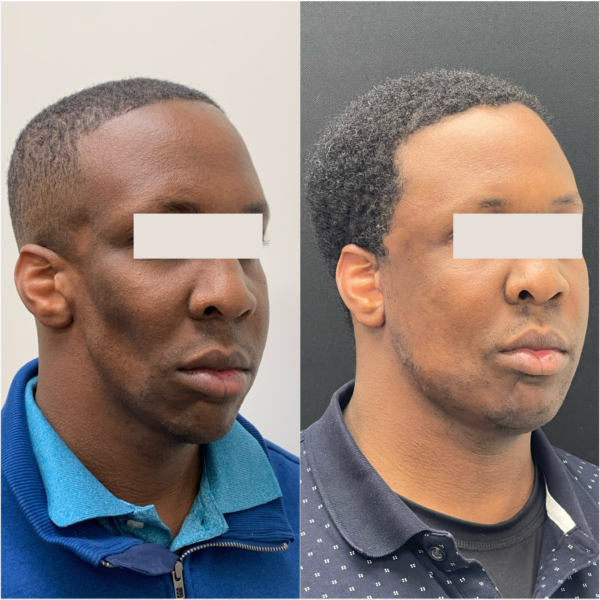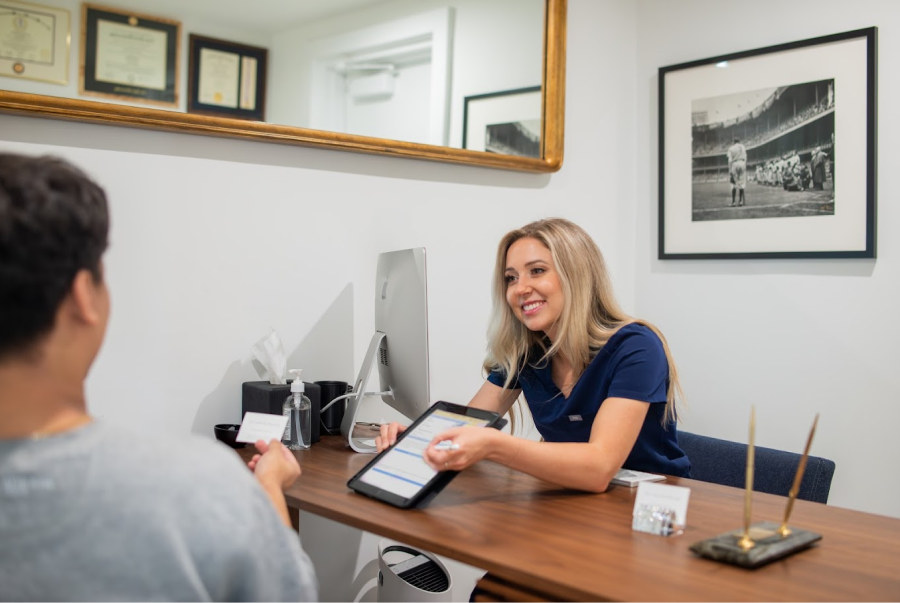Jawline Implants (Custom)
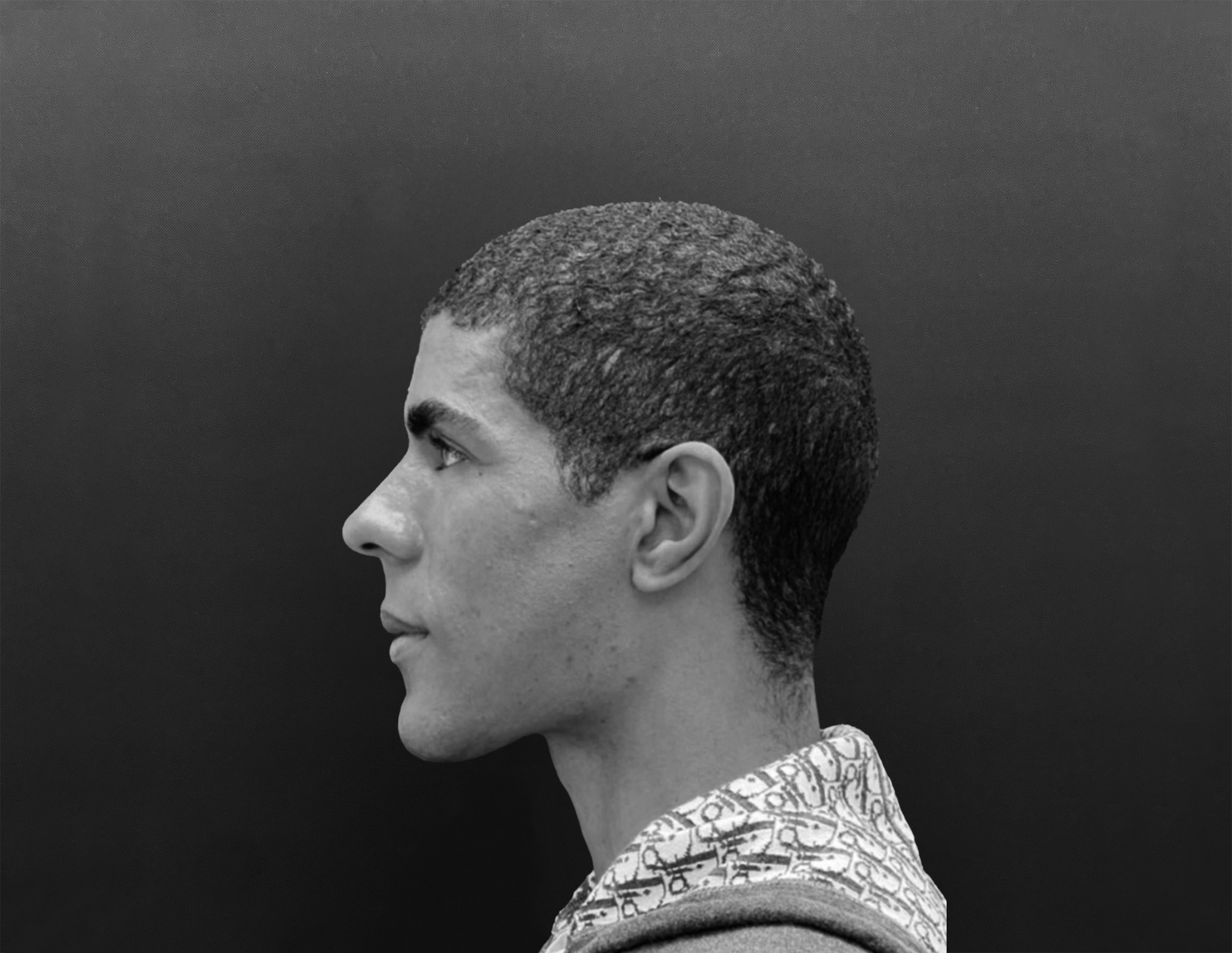
What are Jawline Implants?
Jawline (or “angle”) implants are used to enlarge and enhance the size and shape of the jaw. They can balance facial proportions, enhance jawline definition, and help to support loose skin and soft tissue. They can also restore proper contour to jawline irregularities and step-offs that can result from prior surgery or trauma.
At our practice, access for jawline implants is almost always made inside the mouth. This avoids visible scars on the face and is typically safer. Numerous studies have shown no difference in infection rates when access is made through the mouth vs. through the facial skin.
All facial implants can be custom or non-custom (stock). Custom implants are fabricated and designed from a patient’s CT scan, which we take in-office during the consultation. They are shaped and designed specifically for each patient’s anatomy and aesthetic goals. This “virtual planning” is done by computer and is reviewed with each patient along with predictive imaging prior to production of the custom implants. Adjustments can then be made to the implant design prior to production/fabrication. Non-custom (stock) implants are prefabricated in various shapes and sizes (S, M, L) and do not require a CT scan or virtual planning.*
Common materials for facial implants include silicone, Medpor, titanium, and PEEK (polyetheretherketone). PEEK is largely considered the gold standard and is a solid but flexible material that best simulates bone. It is highly biocompatible (accepted by the body without causing inflammation) and chemically stable so as not to corrode or break down. It is MRI-safe and radiolucent so as not to obscure future X-rays or other imaging.
*In our practice we only offer custom facial implants.
Patient Results
View before and after photos of our patients who had this procedure.
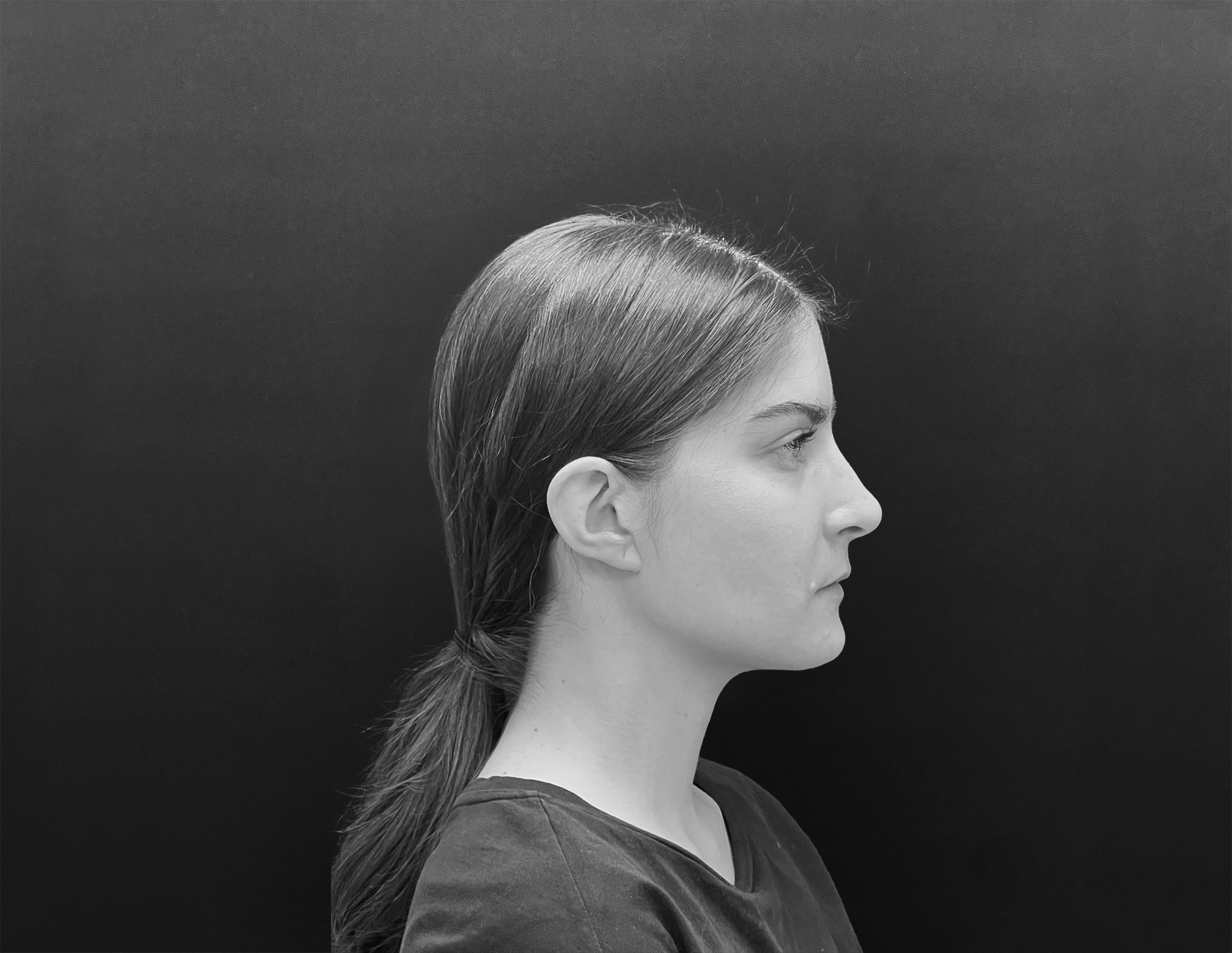
Benefits of
Jawline Implants
- Improved jawline definition
- Improved jawline symmetry
- Increased jaw width and/or height for more balanced facial profile
- Correction of jawline steps or irregularities (such as from prior surgery or trauma)
- Improved bone structure in conjunction with face or neck lift, submentoplasty, or submental liposuction
- They can be designed to create more angularity for a more masculine appearance, or create softness for a more feminine appearance
- Minimal downtime, no scarring (all incisions hidden inside the mouth)
- Permanent results
Why is a CT scan taken at the consultation?
A CT scan is required for proper diagnosis and evaluation of the bone structure so that the custom implants can be designed accurately. It is also needed to rule out any other complicating anatomical factors that would affect decisions regarding the treatment plan.
Who is a good candidate for jawline implants?
You may be a good candidate for jawline implants if you desire increased facial definition or improved facial contours, particularly if you feel your jawline is too soft.
How do jawline implants compare to using fillers for more volume in the jawline area?
When the goal is to create bone structure, filler is not the right option for several reasons. It is a soft material, so it does not lift or build structure, it “fills”. Many patients are satisfied with their fillers at first, but after 5-10 years of filler treatments, they feel their faces look swollen, lumpy, heavy, or fat. They also can stay in the body for 10 years or more. Some literature suggests that large amounts injected over the years expands the skin and soft tissue, resulting in loose skin.
How long do jawline implants last?
Jawline implants are a permanent solution to enhancing the jawline. While the implants themselves are designed to last a lifetime, individual aging factors such as skin elasticity and bone structure changes may impact the overall appearance over time.
Are there different types/materials?
All facial implants can be custom or non-custom (stock). Custom implants are fabricated and designed from a patient’s CT scan, which we take in-office during the consultation. They are shaped and designed specifically for each patient’s anatomy and aesthetic goals. This “virtual planning” is done by computer and is reviewed with each patient along with predictive imaging prior to production of the custom implants. Adjustments can then be made to the implant design prior to production/fabrication. Non-custom (stock) implants are prefabricated in various shapes and sizes (S, M, L) and do not require a CT scan or virtual planning.*
*In our practice we only offer custom facial implants.
Common materials for facial implants include silicone, Medpor, titanium, and PEEK (polyetheretherketone). PEEK is largely considered the gold standard and is a solid but flexible material that best simulates bone. It is highly biocompatible (accepted by the body without causing inflammation) and chemically stable so as not to corrode or break down. It is MRI-safe and radiolucent so as not to obscure future X-rays or other imaging.
How is PEEK different than silicone or Medpor?
Silicone can be custom, but usually is not. It is has a rubbery or gummy consistency. The flexible nature has mobility and causes rubbing against the underlying bone (even if it’s secured) causing erosion of the bone.
Medpor implants can also be custom but usually are not. They have small holes (pores) for soft tissue to grow into, which occurs progressively with time and can make removal very complex and damaging to the surrounding soft tissue. We advise against them.
PEEK is a solid and smooth material that is always custom. These are always secured to the bone, and we feel they have the best surface characteristics, esthetics, and functionality to simulate chin bone (or cheek bones and jaw angles). They can be removed easily, and typically feel completely natural.
What do the implants feel like?
The most common answers from patients who have jawline implants: “It feels like nothing.” “I don’t feel it.” “It feels like me.” “I can’t even tell that something there.” “It feels completely natural.”
Are there scars? Where are the incisions made?
The incisions for jawline implants are typically made inside the mouth. This allows for discreet placement of the implants with no visible scarring.
Can jawline implants be combined with other procedures?
Yes, many patients combine jawline implants with other facial procedures such as chin augmentation, face/neck lift, submental liposuction, or submentoplasty. This is common and often produces the most natural results. During the consultation, we can discuss whether combining procedures would be ideal for your aesthetic goals.
What type of anesthesia is used?
This is commonly done under a light “twilight” (IV) sedation. This allows you to remain comfortable and relaxed during the procedure.
How long does this procedure typically take?
1-2 hours
Do I need to stay overnight at the facility?
No, patients typically return home the same day for this procedure.
What is the recovery time for jawline implants?
Most patients can expect some swelling and bruising for the first week after surgery. Usually after one week, patients can resume work and normal daily activities. Within one week, typically 90% of the swelling and bruising has resolved. The remaining 10% of settling will occur over the next 3-6 months, or sometimes up to a year.
How long until I can be out in public?
Most patients can resume work (and are considered “restaurant-ready”) within 1 week. For social events such as weddings (guest), graduations, or holidays, one should allow at least 2 weeks for recovery.
How soon can I see the results of jawline implants?
You will notice an immediate improvement in your jawline after surgery, though swelling will obscure the final result initially. The majority of swelling typically resolves within the first week.
How soon can I travel after my surgery?
7-10 days, after the one-week postoperative appointment.
How do I choose the right surgeon for this procedure?
It is important to choose a surgeon who has 1) the training and skill set in treating the maxillofacial structures, as well as soft tissue aesthetics of the face, head, and neck; and 2) An aesthetic sense that matches the patient’s. Particularly valuable is the surgeon’s “fellowship” experience, which is elective higher level training performed after the standard residency training. Not every surgeon completes fellowship training.
What are the keys to a successful jawline implant surgery?
- Appropriate selection of implant material and artistic design of the custom implant
- Stable and secure placement of implants with proper technique
- Addressing any related areas such as a heavy neck or sagging skin if present to enhance the appearance of the implants
- Achieving ideal balance of bone structure without over- or under-correction
Do facial implants set off airport metal detectors?
No
Can I still safely get an MRI if I have facial implants?
Yes, no problem. Just let the technician know beforehand.
Are facial implants safe?
Yes, facial implants are considered a very safe procedure when done properly. They have a very low infection and complication rate. Facial implants have been placed for several decades, so it is not a new procedure. Techniques and materials have continued to improve. They are not only used for cosmetic purposes, but also reconstructive purposes, near vital structures such as the eye, brain, and spine with excellent safety metrics.
What happens to facial implants as we age?
Essentially nothing; these implants are stable so they do not corrode or degrade. The added bone structure will offer better support to the soft tissue, so people will typically age better with less skin laxity than they would have otherwise had.
What is the risk of infection or rejection for facial implants?
In global literature between 2-5%. In our practice it is less than 1%.
What happens if there’s an infection?
This can usually be treated with antibiotics alone. Sometimes a fluid collection can be drained as well, and in rare cases the implant would be removed, the tissue would be allowed to clear the infection for 1-2 months, and then an implant can be replaced.
What to Expect
After Surgery
- Most patients can resume work and are considered “restaurant-ready” in 5-7 days
- For social events such as weddings (guest), graduations, or holidays: 2 weeks
- Exercise: Very light activity such as a brisk walk or a light stationary bike is encouraged as soon as the patient feels ready for it after surgery. Light to moderate exercise is usually resumed in about one week and heavy exercise in 2 weeks
- Usually about 90% of swelling/bruising resolves within a week
- Sutures inside the mouth will dissolve on their own in about a week and will not need to be removed
- We will schedule follow-up appointments at typically one week, one month, 3 months, 6 months, and one year to take follow-up CT scan imaging to ensure optimal healing. Some of these appointments can be virtual at the surgeon’s discretion

How are custom implants different than non-custom implants?
Custom implants are designed specifically for each patient based on a CT scan. They are sculpted virtually on the computer to achieve a very precise aesthetic goal in terms of shape and location. They are fixated with small screws to ensure they stay in position. Over time, the body forms a dense fiber capsule over them, which further secures the position. For this reason patients invariably report the feeling of these custom implants as “they feel like nothing”, “they feel like part of me”, “I don’t even feel them”, or “I wouldn’t know that they’re there if I couldn’t see the result”.
Because they are not made specifically for each patient, non-custom implants are much less expensive but tend to fit less ideally. This causes tiny movements over time, which eventually erodes the bone underneath. They are also made of lower-quality materials, since the gold-standard PEEK material needs to be custom-made to fit precisely on the bone due to its rigid nature.
